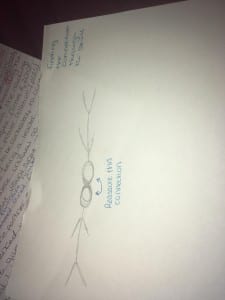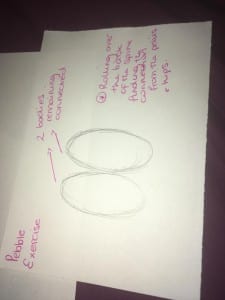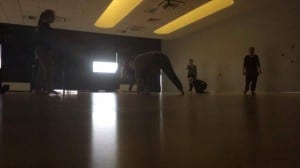The use of weight shifts and incorporating tools learnt over previous sessions .
I found a phenomenological approach to choreography when finding flow and fluidity. I searched my thoughts and opinions focussing upon the mind/body and how they work in an intrinsic accompaniment approach. We are told about ‘body doing’ and ‘mind doing’ (Sheets-Johnstone,M. 2017 p9) From these inclinations I found it necessary of how both create a full perception of movement. Creating a ‘mindful body’ showing there is no separation and therefore work together.
I found great attentiveness with this reading ‘A Question?’ (Lepkoff, D. 2008) we are informed that ‘Perception follows attention.’ (Lepkoff, D. 208) I feel that this argues consciousness of phenomenal experiences, questioning the consciousness and attention; to explore the form of feelings, sensations, perceptions and memories. This quote made me think back to our session on Lead and follow, drifting through the space with eyes closed, initiating the movement from the head, the partner moving the head for us. I had no vision, so was I conscious or unconscious during this process?
‘Stuck in table top’ a reading given to us by Kirsty earlier in the week. I can certainly relate to this feeling of being stuck in table top I definitely did in the first Jam this week. I was thinking too much instead of just ‘letting go’. We are told ‘No one ever said they table top is a static position or a destination point’ (Richard, 2012) I approached this idea during my improvisations, realising how often I do hold table top, so I attempted more fluidity to enhance momentum for on going explorations.
Tools:
Pebble
Aikido roll/table top
Surf& roll
Table top- roll backwards/forwards
I was super excited when told we’re going ‘up’ using the middle kinesphere of the body. I struggled to lift people smaller than me, as there was a lot of pressure on my knees, I was therefore aware that I have weak knees. There was difficulty amongst lifting a body that is different shape and size to me, when trying to jigsaw my spine.
I found the first Jam daunting and felt challenged when attempting to use the tools within an improvisation. However I pursued and fought through the journey, playing with movement tools creating fluidity, unfortunately on numerous occasions we fell on each other or bodies gave way so was hard to concentrate and keep focus, however we composed ourself after a times.
I was anxious about the second Jam as to how it would go as the initial did not go as I’d of hoped however I was really pleased with the second, I worked with the quality of movement finding the relaxation and sensations within the tools, fluidly moving into explorative ideas, trying out new ways of movement. I found I had more play within my improvisations today.
I was curious how to enter space when a duet is in process, can it be disturbed?
Will we work as a trio?
Will someone leave the space? What movement tools can we use?
How explorative can we be with more than 2 bodies?
I involved myself, I entered the space sitting back to back with Jess M and Charlie awaiting who would initiate movement. The anticipating was intriguing. We shuffled across the floor, Charlie left the space, so myself and Jess connected and reformed our contact, Jess moved my left arm and created interesting explorations of lead and follow, testing the touch improvisation of taking turns until a tool explored. I had never improvised with Jess M before, I did thoroughly enjoyed finding myself and partners limitations. We were fully engaged throughout and listened to one another’s body. We took influence from previous sessions building a challenged contact improvisation, I felt reassured by my partners contact, I worked positively within this Jam and took a lot of understandings from trial and error.
Lepkoff, D. (2008) Contact Improvisation: A Question, 1-2. Available from: http://www.daniellepkoff.com/Writings/CI%20A%20question.php [accessed 25 October 2017]
Richard (2012) You don’t have to stop moving in table top- be an underdancer [blog] 22 December. Available from: http://contactimprovblog.com/you-don’t-have-to-stop-moving-in-table-top-be-an-under-dancer/ [accessed 25 October 2017]
Sheets-Johnstone, M. (2017) Thinking in Movement. Contact Quartely, Vol 42:1, pp.7-12Ok



